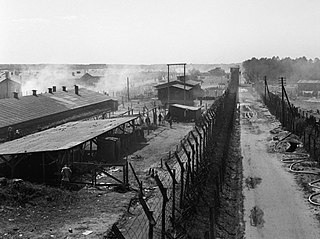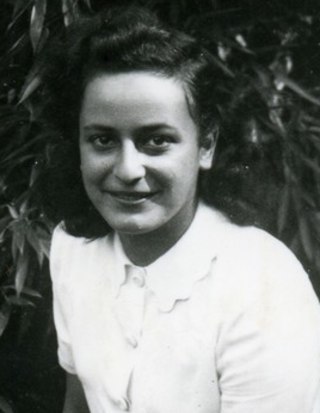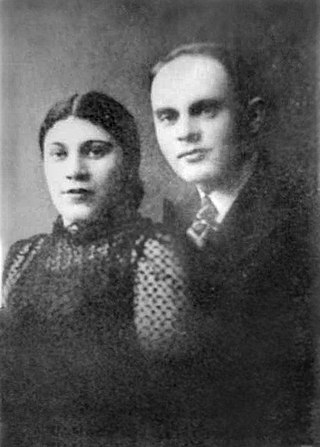
Auschwitz concentration camp was a complex of over 40 concentration and extermination camps operated by Nazi Germany in occupied Poland during World War II and the Holocaust. It consisted of Auschwitz I, the main camp (Stammlager) in Oświęcim; Auschwitz II-Birkenau, a concentration and extermination camp with gas chambers; Auschwitz III-Monowitz, a labour camp for the chemical conglomerate IG Farben; and dozens of subcamps. The camps became a major site of the Nazis' Final Solution to the Jewish question.

Camp Westerbork, also known as Westerbork transit camp, was a Nazi transit camp in the province of Drenthe in the Northeastern Netherlands, during World War II. It was located in the municipality of Westerbork, current-day Midden-Drenthe. Camp Westerbork was used as a staging location for sending Jews, Sinti and Roma to concentration camps elsewhere.

Bergen-Belsen, or Belsen, was a Nazi concentration camp in what is today Lower Saxony in northern Germany, southwest of the town of Bergen near Celle. Originally established as a prisoner of war camp, in 1943, parts of it became a concentration camp. Initially this was an "exchange camp", where Jewish hostages were held with the intention of exchanging them for German prisoners of war held overseas. The camp was later expanded to hold Jews from other concentration camps.

The Holocaust—the murder of about six million Jews by Nazi Germany from 1941 to 1945—is the most-documented genocide in history. Although there is no single document which lists the names of all Jewish victims of Nazi persecution, there is conclusive evidence that about six million Jews were murdered. There is also conclusive evidence that Jews were gassed at Auschwitz-Birkenau, the Operation Reinhard extermination camps, and in gas vans, and that there was a systematic plan by the Nazi leadership to murder them.

Esther (Etty) Hillesum was a Dutch Jewish author of confessional letters and diaries which describe both her religious awakening and the persecutions of Jewish people in Amsterdam during the German occupation. In 1943, she was deported and murdered in the Auschwitz concentration camp.

The Auschwitz Protocols, also known as the Auschwitz Reports, and originally published as The Extermination Camps of Auschwitz and Birkenau, is a collection of three eyewitness accounts from 1943–1944 about the mass murder that was taking place inside the Auschwitz concentration camp in German-occupied Poland during the Second World War. The eyewitness accounts are individually known as the Vrba–Wetzler report, Polish Major's report, and Rosin-Mordowicz report.

Helga Deen was a Jewish diarist whose diary was discovered in 2004, which describes her stay in a Dutch prison camp, Kamp Vught, where she was brought during World War II at the age of 18.

Herzogenbusch was a Nazi concentration camp located in Vught near the city of 's-Hertogenbosch, Netherlands. The camp was opened in 1943 and held 31,000 prisoners. 749 prisoners died in the camp, and the others were transferred to other camps shortly before Herzogenbusch was liberated by the Allied Forces in 1944. After the war, the camp was used as a prison for Germans and for Dutch collaborators. Today there is a visitors' center which includes exhibitions and a memorial remembering the camp and its victims.

The issue of why the Allies did not act on early reports of atrocities in the Auschwitz concentration camp by destroying it or its railways by air during World War II has been a subject of controversy since the late 1970s. Brought to public attention by a 1978 article from historian David Wyman, it has been described by Michael Berenbaum as "a moral question emblematic of the Allied response to the plight of the Jews during the Holocaust", and whether or not the Allies had the requisite knowledge and the technical capability to act continues to be explored by historians. The U.S. government followed the military's strong advice to always keep the defeat of Germany the paramount objective, and refused to tolerate outside civilian advice regarding alternative military operations. No major American Jewish organizations recommended bombing.

Holocaust trains were railway transports run by the Deutsche Reichsbahn and other European railways under the control of Nazi Germany and its allies, for the purpose of forcible deportation of the Jews, as well as other victims of the Holocaust, to the Nazi concentration, forced labour, and extermination camps.

Rut "Rutka" Laskier was a Jewish Polish diarist who is best known for her 1943 diary chronicling the three months of her life during the Holocaust in Poland. She was murdered at Auschwitz concentration camp in 1943 at the age of fourteen. Her manuscript, authenticated by Holocaust scholars and survivors, was published in the Polish language in early 2006. English and Hebrew translations were released the following year. It has been compared to the diary of Anne Frank.

Hélène Berr was a French woman of Jewish ancestry and faith, who documented her life in a diary during the time of Nazi occupation of France. In France she is considered to be a "French Anne Frank". She died from typhus during an epidemic of the disease in Bergen-Belsen concentration camp that also killed Anne Frank and her sister Margot.

Franz Hößler, also Franz Hössler was a Nazi German SS-Obersturmführer and Schutzhaftlagerführer at the Auschwitz-Birkenau, Dora-Mittelbau and Bergen-Belsen concentration camps during World War II. Captured by the Allies at the end of the war, Hößler was charged with war crimes in the First Bergen-Belsen Trial, found guilty, and sentenced to death. He was executed by hanging at Hameln Prison in 1945.

Nieuw Vosseveld is a prison in Vught, Netherlands, part of the Custodial Institutions Agency of the Ministry of Justice and Security within the Dutch criminal justice system. Penitentiaire Inrichting Vught is now the general term used instead of Nieuw Vosseveld. Part of Nieuw Vosseveld is a maximum security prison; it holds some of Europe's most dangerous criminals, including Mohammed Bouyeri and Ridouan Taghi.

Philip "Flip" Slier was a Dutch typesetter of Jewish origin who lived in Amsterdam during the German occupation of the Netherlands in World War II. At the age of 18, he received a letter from the Jewish Council of Amsterdam—under orders from the German occupiers—that he was to report to Camp Molengoot or face arrest. He wrote 86 letters from 25 April to 14 September 1942 detailing his experiences as a forced labourer at the labour camp. Eventually he escaped to Amsterdam and lived as an onderduiker ; he frequently disguised himself and moved to different hiding locations to evade detection.

Zalman Gradowski or Chaim Zalman Gradowski originally from Suwałki, was a Polish Jewish prisoner of the Auschwitz-Birkenau concentration camp during the Holocaust in occupied Poland. On November 2, 1942, he was deported, as were all Jews then living in Lunna, as well as neighboring towns, to the Kielbasin (Kolbasino) transit camp. On December 5, he and all his Jewish townsfolk were forcibly marched from the Kielbasin transit camp to Lososno, Poland, where they boarded a train bound for, as he later discovered, Auschwitz. The train arrived in Auschwitz-Birkenau on the morning of December 8. After "selection" at Auschwitz-Birkenau, his family members as well as all women and children, and most of the men who were on the transport, were immediately sent to the gas chamber and murdered. Shortly afterward, Gradowski and several others from the transport who survived the “selection” were sent to work in crematoria as part of the Sonderkommando slave labour unit.
Jean Claire Adrien Mesritz was a Dutch Resistance Fighter during World War II. He was the elder brother of Denis Mesritz.
: Lieve vrinden, we zijn nu dicht bij de grens. Het is wel teleurstellend, maar we waren erop voorbereid en zijn vol vertrouwen. Ik denk veel aan jullie. (...) Ik heb alle brieven en foto's bij me. M'n liefste bezit. Wanneer zien we elkaar weer? Dat zal nu wel lang duren. Maar erdoor komen we. (...) Heel veel liefs jongens, bedankt voor alles. Tot ziens.
: 'Dear friends, we are close to the border now. It is very disappointing, but we were prepared for it and remain hopeful. I think a lot about you. (...) I've got all your letters and photos with me. My dearest possessions. When will we see each other again? That will take a long time. But we shall survive. (...) Lots of love guys, thanks for everything. Goodbye.















